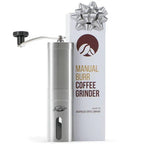The moka pot is a classic coffee brewer found in households across the globe.
Although invented in 1933 by Luigi di Ponti, it was Alfonso Bialetti—an Italian engineer—who brought the world-famous brew method into homes everywhere. This invention marked the transition from coffee as an “out of home” luxury to a modern morning necessity.
However, coffee brewed in a moka pot gets a bad reputation for being overly bitter, heavy, and “burnt” tasting. (We’ll show you how to fix all of that!) Leading many coffee drinkers to opt for another brewing method.
But, moka pot coffee can be rich, smooth, and full of sweet flavors when brewed correctly.
Today, we’ll review the five things every moka pot user needs to know to brew outstanding coffee at home—some of which may surprise you.
If this is your first time brewing with a moka pot, be sure to review our Ultimate Guide to Brewing Moka Pot Coffee before diving in.
1. Moka Pots Don’t Brew Espresso
When coffee lovers want to brew espresso at home, they often believe a moka pot will do the trick.
Sorry, moka pots do not brew espresso. Moka pot coffee bears a lot of resemblance to espresso but sadly falls short in the grand scheme of things.
Read: The Ultimate Guide to Espresso
Both espresso and moka pot coffee are brewed using pressure. But, the moka pot is incapable of producing enough pressure to brew coffee as strong or as concentrated as espresso. True espresso is brewed with ~6-9 bars of pressure, while a moka pot is only able to produce 1 or 2 bars.
So, why do so many people believe moka pots brew espresso? Marketing.
Moka pots are promoted as stovetop espresso brewers. Although the result is close to the syrupy body and bittersweet flavors of a well-prepared espresso, it’s not the same.
If you want to brew up a cappuccino or americano in a pinch, a moka pot will work fine. However, for espresso that lives up to expectations, you’ll need to use a home espresso machine.
2. Moka Pots Come in Many Sizes
Moka pots are sold in several sizes. You can buy a single cup moka pot or one that brews up to 12 cups, the choice is yours.
But it’s a critical choice. Moka pot sizes are not adjustable.
A 6-cup moka pot will brew six cups of coffee—and only six cups of coffee. Using less water or grounds to brew less coffee often results in over-extraction and other undesirable coffee characteristics.
Think about how much coffee you plan to brew at a time and purchase the moka pot that satisfies that amount.
Read: How to Pick the Perfect Moka Pot
3. You Can Troubleshoot Moka Pot Coffee
Far too many coffee drinkers have sworn off moka pot coffee due to the bitterness or heavy mouthfeel. It’s not uncommon for people to feel this way either. Moka pots are finicky little brewers!
If you’re not careful, you can easily brew an over-extracted and super bitter cup of coffee with the moka pot.
Fortunately, bitter moka pot coffee can be remedied with a few tricks.
On the other hand, if your coffee is too sour or weak, you’ll want to:
Still not satisfied? Try adding hot water to the coffee after brewing. This balances out the strong, heavy coffee flavors and characteristics the moka pot is known for.
If the coffee still tastes bad after trying all our troubleshooting tips… it’s your coffee beans. Freshly-roasted whole bean coffee ground right before brewing is the only way to go.
4. Moka Pot Coffee is Under a Lot of Pressure
Aren’t we all?
Puns aside, the moka pot is a pressurized coffee brewer. While pressure is the key to the heavy characteristics of the coffee, it can also be a recipe for disaster.
Don’t create any unwanted pressure by packing the coffee basket grounds too tight.
This means no tamping or not using a super-fine grind size. Remember, espresso machines are built to withstand high amounts of pressure—moka pots aren’t.
5. Do Not Put Your Moka Pot in the Dishwasher
The majority of moka pots, including Bialetti brewers, are made out of anodized aluminum. If you put this in the dishwasher, the materials will oxidize and turn the moka pot a dark, black color.
If this happens and the moka pot becomes corroded, do not use it.
Instead of the dishwasher, hand clean your moka pot to eliminate built-up grounds, clogs, and stains.
Read: The Quick Guide to Moka Pot Safety and Cleaning
The Secret to Rich Moka Pot Coffee? The Right Beans.
Even with all the best moka pot tips and tricks up your sleeve, you still won’t have smooth, sweet coffee if you’re using low-quality beans.
Old, stale, pre-ground coffee will make your moka pot taste bitter or just downright bad.
You want your moka pot brewing experience to be enjoyable and with a delicious result. The only way to get there is by using whole bean specialty-grade coffee.
By grinding your coffee beans right before you brew, you unlock a world of exciting natural flavors—from decadent milk chocolate to sweet blueberries and beyond.


